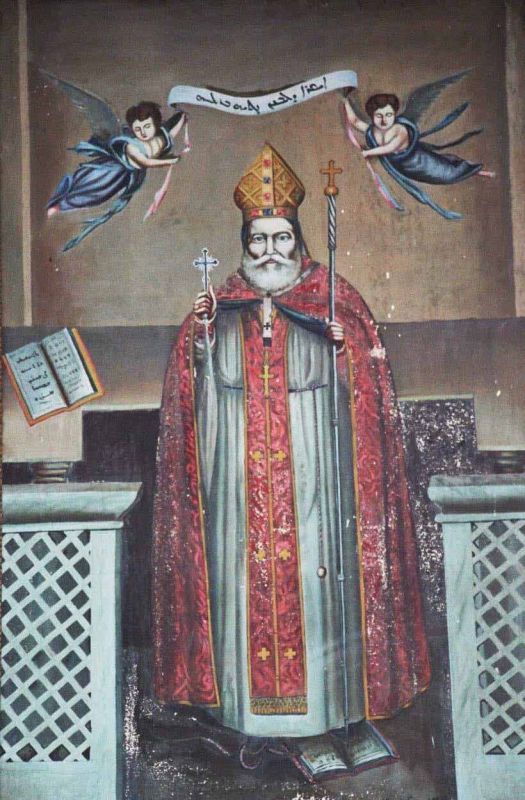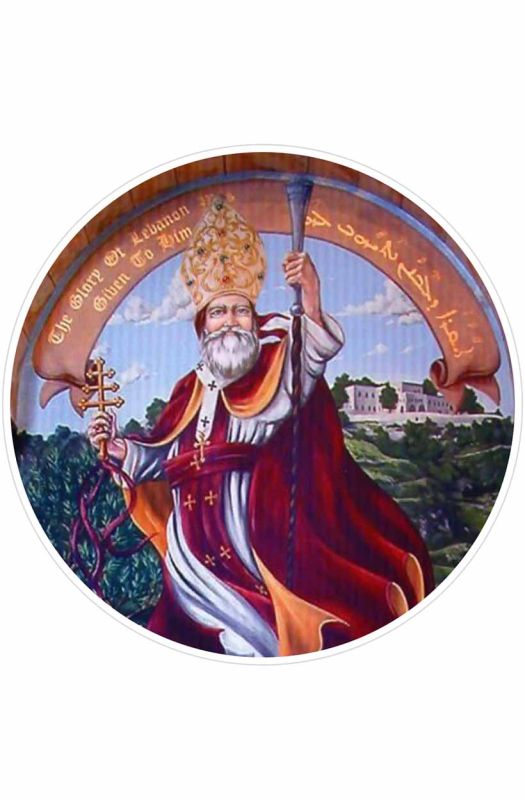
Saint John Maron was born in Antioch and died in 707 in Kphar-Haï. He is recognized as the founder of the Maronite Syriac Church of Antioch and the pioneer of Lebanese identity. He established the modern Lebanese state on geographical (Mount Lebanon), religious (Chalcedonian Christianity), linguistic (Syriac) and military (the Mardaites) foundations.
John (Yohanon), born in the 7th century in the region of Antioch in Sermin (Sermania) to Aghathon and Anohemia, was proficient in both Greek and Syriac languages. He pursued his studies in Antioch and Constantinople. While his writings are preserved in Syriac, he is also oftentimes referred to as Ioannes Maro.
His Roots
His biography is marred by many uncertainties and anachronisms. According to the Series Chronologica, his father, Aghathon, is said to be related to Charlemagne’s family. However, can his ties to the Frankish community in Antioch account for such a noble lineage – or even such a specific one – given that Charlemagne was born a century later? On the other hand, according to his editor, Abbot François Nau, "If we were to solely rely on his works and pinpoint his era, we would certainly place him in the 6th or early 7th century, as the last mentioned council is that of Chalcedon (451), and the final cited testimony is that of Patriarch Severus of Antioch (died in 543)."
The story of Saint John Maron was passed down by Patriarch Estephanos Doueihi, who penned it a millennium later, towards the end of the 17th century. He drew upon ancient Syriac manuscripts, the research of Maronite scholars in Rome, and chronicles disclosed in 1495 by Maronite Bishop Gabriel Barcleius.
Among the facts acknowledged by the Maronite Church, it is ascertained that John entered the convent of Saint Maron to become a monk, adopting the monastic name Yohanon Moroun (John Maron). Unlike the majority of Syriac monasteries divided between Monophysitism and Nestorianism, those known as "Beit-Moroun" were Chalcedonian and thus adhered to the official doctrine of the Byzantine Empire.
In 677 or 686, depending on various sources, John Maron was consecrated bishop of Botrys (Batroun) in Phoenicia, allegedly by the papal legate cardinal, at the request of the Franks of Antioch and their prince, Eugene. The exact date cannot be exactly determined, given that the mere existence of the Frankish prince Eugene and the papal legate in Antioch at that time is somewhat strongly questionable.
 Ancient representation of Saint John Maron with the inscription "iqoro de Levnon nétihév léh" (may the glory of Lebanon be given to him").
Ancient representation of Saint John Maron with the inscription "iqoro de Levnon nétihév léh" (may the glory of Lebanon be given to him").The Election at the Patriarchal Seat
With the Muslims' conquest of Antioch, the patriarch fled to Constantinople, where he eventually passed away, leaving the patriarchal seat vacant. Byzantium then turned to the Syriacs to elect a successor, focusing on the Chalcedonians, hence the monks of Beit-Moroun, who convened to elect the Bishop of Botrys to the seat of Antioch.
Sometime between 687 and 701 (the exact date remains uncertain), at the Holy See, Pope Sergius I (who hailed from Antioch and was a Syriac), acknowledged John Maron as patriarch of that city. However, the list of Orthodox patriarchs of Antioch does not mention him, hence pointing to a vacancy from the years 702 to 742, spanning from George II to Stephen III.
During this period, Mount Lebanon secured its independence through the victory of the Mardaites over the Arabs. To escape from the Muslim invader, as well as from the interference of the Byzantine hierarchy, the new patriarch chose to transfer his seat to Mount Lebanon.
The Creation of Lebanon
Saint John Maron established his patriarchal seat in his episcopal diocese, in Kphar-Haï (the village of life in Syriac). The new prelate founded the modern Lebanese state on geographical (Mount Lebanon), religious (Chalcedonian Christianity), linguistic (Syriac) and military (the Mardaites) foundations.
The Mardaites were warriors – presumably from the Caucasus – and were entrusted with safeguarding the Levant. They emerged victorious in numerous battles against the Arabs, prevailing in conflicts across coastal towns and the Beqaa Valley, even imposing substantial tribute obligations upon them. Following the signing of the 667 peace treaty between Caliph Muawiya and Byzantine Emperor Constantine IV, the latter ordered the withdrawal of his – Mardaite – troops from Lebanon. In return, he received an annual economic contribution from the caliphate.
Another 12,000 Mardaites retreated under Justinian II, who had a previous military confrontation with the Maronites in 684. Around 695, these contingents left for Isauria, in northern Cilicia. Therefore, the Mardaites who remained in Lebanon constituted the needed army that would support the establishment of Patriarch John Maron's political entity.
They chose Baskinta as their capital, and earned the respect of their new Arab neighbors, compelling two Umayyad caliphs to pay tribute to them from the year 661 to 750 (Encyclopaedia Britannica). The Mardaites couldn’t be conquered by any Arab dynasty until the arrival of the Franks in the Levant at the end of the 11th century and the capture of Tripoli by Raymond de Saint-Gilles in 1109. Saint John Maron’s successors, notably Jeremiah of Amchit (1199-1230), subsequently allied themselves with the emerging Christian military power: the Crusaders.
 Modern representation of Saint John Maron with the inscription "iqoro de Levnon nétihév léh" (“may the glory of Lebanon be given to him").
Modern representation of Saint John Maron with the inscription "iqoro de Levnon nétihév léh" (“may the glory of Lebanon be given to him").Literature
While some scholars questioned the authenticity of the facts and the literature attributed to Saint John Maron, the Maronite Church acknowledges three literary works preserved in Syriac and edited by Abbot François Nau. They include three theological writings: a faith related account, a controversial work against Monophysitism and another against Nestorianism.
Among the manuscripts that contain these texts, four explicitly attribute authorship to "John Maron, Patriarch of Antioch." However, these are subsequent copies, two of which mention the dates 1392 and 1470, in that order.
Saint John Maron is recognized as the founder of the Syriac Maronite Church of Antioch and the pioneer of Lebanese identity. His holy picture is ever accompanied by the verse from the Book of Achaia (Isaiah) "iqoro de Levnon métihév léh" (the glory of Lebanon is given to him) inscribed in Syriac letters. He inspired the Chalcedonian Syriacs to espouse his name, whereas until then, the word Maronites only referred to the monks.
The Catholic Church acknowledged the sanctity of this venerable patriarch, and honors him on March 2. He is laid to rest at the monastery of Kphar-Haï, which bears his name, where he once officiated and where he passed away on February 5, 707 AD.
Read more



Comments